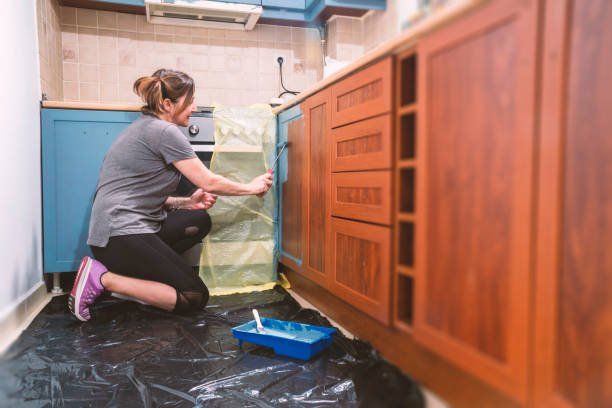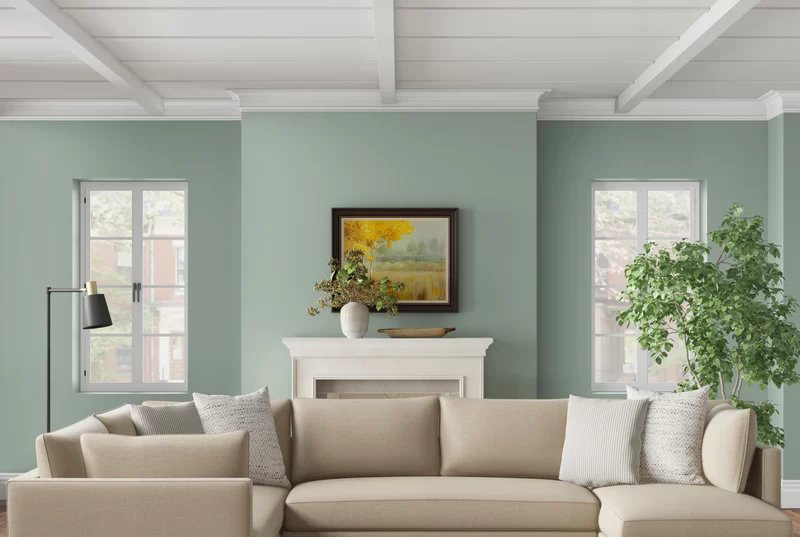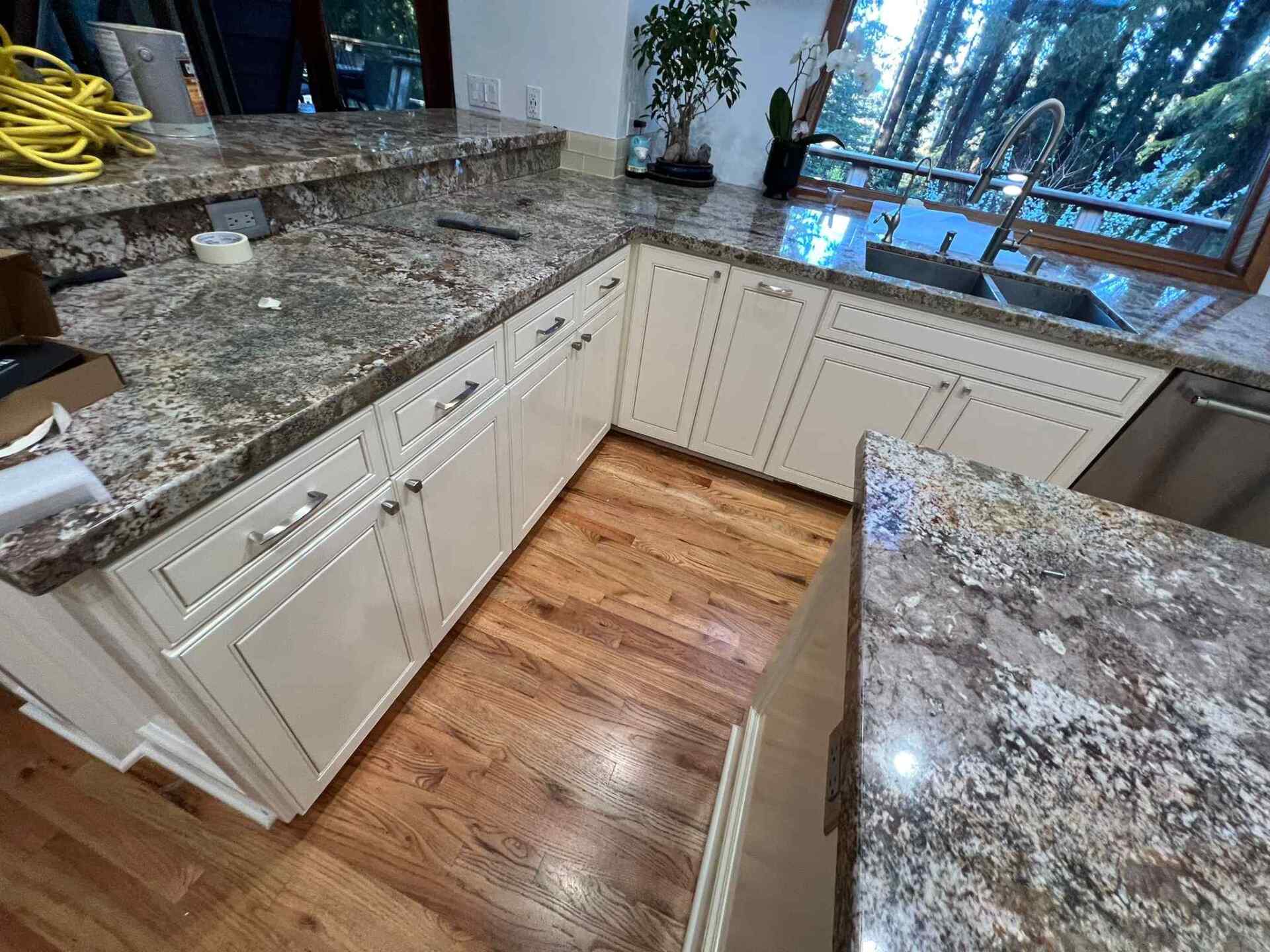Commercial Interior Painting: Choose the Right Paint for Your Business Space
The lifespan of commercial interior paint is typically three to five years, depending on traffic and wear patterns.
Selecting an inappropriate paint can exacerbate deterioration, leaving walls vulnerable to damage and necessitating more frequent refurbishment.
Understanding Paint Durability
Durability in paint is not simply about withstanding wear; it's fundamental to a paint's ability to maintain its aesthetics and protective qualities over time. It's a pivotal consideration, especially in high-traffic commercial environments.
In broader terms, commercial-grade paint often encompasses robust formulations designed to resist physical impacts, abrasions, and frequent cleanings. These fortified paints not only endure but retain their integrity and appearance under rigorous conditions, prolonging the intervals between repaintings.
Terms like “washable” and “scrubbable” denote a paint’s resilience to cleaning processes--a significant factor in longevity for active business settings.
Assessing Traffic and Wear
Choosing the right paint involves understanding the frequency and intensity of foot traffic in your business space. High-quality paint can resist the stress of high-traffic areas, preserving the aesthetic and structural integrity of walls.
In areas of extensive wear and constant use, durability becomes crucial. The correct paint selection minimizes maintenance, resisting scuffs and preserving color fidelity over time.
Investing in a robust paint solution can preempt costly refurbishments, creating a clean and professional ambiance that withstands the daily demands of business operations.
Comparing Finish Longevity
The endurance of a paint's finish is intrinsically linked to its formulated lifespan. Premium paints often promise extended durability, enhancing the intervals between necessary touch-ups or complete repaints.
Moreover, the finish choice—matte, eggshell, satin, semi-gloss, or high-gloss—impacts longevity in a nuanced manner. A matte finish may absorb more dirt and stains, thus requiring more frequent cleaning, which can erode the coating over time. On the contrary, glossier finishes typically offer better washability and resilience, thereby extending the lifespan of the painted surface.
Consequently, the selection of finish must consider the environmental conditions of the commercial space. Areas exposed to higher levels of moisture, such as bathrooms and kitchens, benefit from semi-gloss or high-gloss finishes, which repel water effectively and inhibit mold growth.
Ultimately, an informed choice necessitates the evaluation of both the paint quality and finish type. Adequate resilience to UV light, moisture, and physical contact is imperative for maintaining the aesthetic appeal. High-traffic areas demand finishes that support frequent cleaning without loss of sheen, ensuring a professional appearance over an extended period.
The Science of Color Selection
The psychology behind color selection is integral to fostering a desired atmosphere within commercial spaces. Colors have the power to influence mood, trigger psychological responses, and even affect productivity. The appropriate palette can promote a sense of calm in a healthcare facility, invigorate energy in a fitness center, or enhance focus in an office environment. It is essential to choose hues that align with your brand’s identity and the functional goals of your space. Consideration of color theory and the effects of specific color schemes on behavior and perception should guide your decision-making process, ensuring that the chosen colors contribute positively to the ambiance and effectiveness of your business environment.
Affecting Mood and Productivity
The strategic use of color can profoundly impact the mood and productivity within a commercial space.
- Calm and Focus: Blues and greens are known to induce calmness and improve focus, making them ideal for offices and educational facilities.
- Energy and Excitement: Bright colors such as reds and oranges foster energy and excitement, suitable for dynamic environments like fitness centers.
- Balance and Harmony: Neutral tones provide balance and can contribute to a harmonious environment, beneficial in spaces where decision-making occurs.
- Creativity and Imagination: Purples and certain vibrant patterns can stimulate creativity, often used in design studios and creative agencies.
- Comfort and Warmth: Earthy tones and soft yellows can create a sense of warmth and comfort, perfect for hospitality or residential care settings.
Selecting a color scheme that mirrors your operational objectives can lead to enhanced workforce efficiency and client satisfaction.
Tailoring your interior palette to facilitate the desired atmosphere is not only a smart branding move but a catalyst for improving overall business performance.
Reflecting Your Brand Identity
Selecting the appropriate color and paint type is imperative in forging a tangible extension of your brand identity.
- Consistency: Ensure color schemes align with your logo and branding materials.
- Industry Appropriateness: Select hues that resonate with your industry's standards and consumer expectations.
- Psychological Impact: Consider the psychological effects of colors on clients and employees.
- Cultural Significance: Acknowledge cultural connotations of colors in your market.
The visual aesthetics of your paint choices speak volumes to clients before a single word is exchanged.
Crafting a space that resonates with your brand values fosters a cohesive and memorable experience for everyone involved.
Specialty Paints for Unique Demands
In environments demanding enhanced durability and hygiene, specialty paints become essential. Facilities such as hospitals, laboratories, and food preparation areas necessitate antimicrobial and mold-resistant coatings to enforce safety and longevity. Equally, in spaces prone to heavy wear and frequent cleaning, like educational institutions and high-traffic commercial zones, epoxy-based or polyurethane paints offer the requisite resilience and ease of maintenance.
Furthermore, the inclusion of low-VOC (Volatile Organic Compounds) or zero-VOC formulas is increasingly sought to minimize environmental impact and health risks. These specialized paints not only contribute to a more sustainable operation but also ensure compliance with stringent industry regulations for indoor air quality, underscoring a corporation’s responsibility towards its stakeholders' wellbeing.
Antimicrobial Options for Health
Antimicrobial paints actively suppress microbial growth.
In healthcare facilities, the use of antimicrobial paint is non-negotiable. These advanced coatings are imbued with agents that inhibit the proliferation of bacteria, mold, and mildew. Given the imperative to maintain a sterile environment, antimicrobial paints are paramount in areas such as patient rooms, operating theatres, and common areas. Moreover, their application is not just limited to healthcare settings but extends to any environment keen on upholding high standards of hygiene.
These paints are instrumental in infection control.
Consider facilities that cater to vulnerable populations - here, antimicrobial paints are a must. They provide an additional layer of protection, reducing the risk of healthcare-associated infections (HAIs). This is not a mere enhancement but a fundamental component of a health-focused design strategy.
These coatings offer long-term defense against pathogens.
A judicious selection of antimicrobial coatings can greatly impact infection control measures. With the advancements in coating technologies, commercial spaces now have access to products that offer enduring antimicrobial properties, ensuring that painted surfaces are not just visually appealing but also serve as a barrier to microbial contamination. As we navigate the complexities of public health in 2023, these innovative solutions stand at the forefront of preventative strategies within built environments.
Eco-Friendly Solutions
Sustainability is increasingly at the forefront of business practices, driving demand for eco-friendly interior paints. Utilizing such products not only reflects corporate responsibility but also ensures a safer, toxin-free environment for employees and clients alike.
Green alternatives minimize VOC emissions in your workspace.
Low or zero-VOC (Volatile Organic Compounds) paints reduce airborne chemicals, enhancing indoor air quality significantly.
These paints contribute to a healthier indoor atmosphere.
By opting for eco-friendly paints, businesses address environmental concerns while prioritizing the well-being of their associates. In the Bay Area, where environmental consciousness is paramount, such a choice is both a statement and a practice in sustainability.
In the selection process, certification labels like Green Seal and EcoLogo assure standards are met.
These certifications indicate compliance with stringent environmental criteria, providing assurance that the chosen paint products are sustainably manufactured, have reduced ecological footprints, and contribute to healthier interior spaces.
Furthermore, green paints can contribute to LEED certification points.
Adopting eco-conscious paints can positively influence a business's LEED score, demonstrating a commitment to sustainable practices and potentially resulting in operational cost savings. It's a strategic move that benefits both the environment and the business's image.
Professional Application Techniques
A masterful paint application hinges not only on the quality of the paint but also on the precise techniques employed. Skilled professionals use a systematic approach, ensuring a uniform coat and impeccable finish. Critically, the nuances of the specific space—be it an office or a warehouse—guide the technique selection, ensuring the paint complements the room's function.
When it comes to applying paint in a commercial setting, accuracy and efficiency are paramount. Expert applicators often utilize advanced equipment such as airless spray technology, which can expedite the process while offering superior coverage. Adopting such modern methodologies is crucial for achieving a consistent and durable finish, which withstands the rigorous demands of a commercial environment.
Surface Preparation Essentials
Optimal surface preparation is pivotal for achieving a durable and aesthetically pleasing paint finish.
- Clean the surface thoroughly to remove dirt, dust, and contaminants that can prevent adhesion.
- Repair any damage such as dents, holes, or cracks to ensure a smooth and even application.
- Sand the surface if necessary, to create a roughened texture for better paint grip.
- Apply a quality primer to enhance paint adhesion and to provide a uniform base for color.
- Ensure the surfaces are dry and free from moisture before beginning the paint application.Surface irregularities must be addressed before painting to ensure the longevity of the finish.
Adhering to these preparation standards establishes a robust foundation for the subsequent application of commercial interior paint.
The Impact of Expert Application
Expertly applied commercial paint transforms mere walls into professional canvases that exude quality.
In matters of commercial interior painting, precise technique coupled with high-grade materials, ensures a finish that resonates with durability and visual appeal.
Professionals leverage their nuanced understanding of painting technologies to deliver a seamless coat that stands the test of time and business activity.
By meticulously treating each stage of application as critical, experts employ tactics such as back rolling and feathering, thus avoiding laps and inconsistencies.
The final product is thus not only a representation of color, but a testament to technical prowess and aesthetic precision.
You might also like
Book A Service Today



